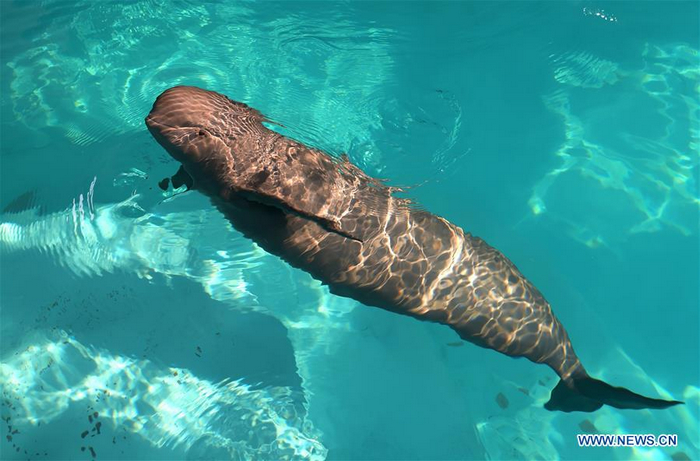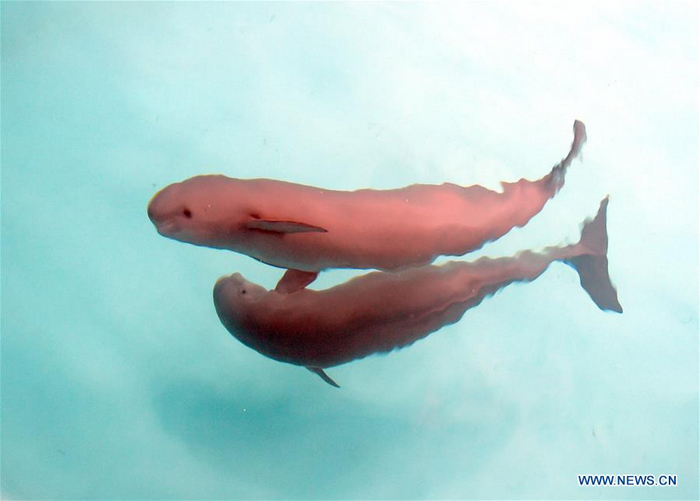

A 7-year-old pregnant finless porpoise named as "F9" swims in the Institute of Hydrobiology under Chinese Academy of Sciences, in Wuhan, central China's Hubei Province, May 10, 2016. The current finless porpoise population, according to scientists, is less than 1,000. As one of the most endangered animals, the finless porpoise is mainly to be found in the middle and lower reaches of Yangtze River and the connecting Poyang and Dongting lakes. (Xinhua/Cheng Min)

A finless porpoise swims in the Institute of Hydrobiology under Chinese Academy of Sciences, in Wuhan, central China's Hubei Province, May 10, 2016. The current finless porpoise population, according to scientists, is less than 1,000. As one of the most endangered animals, the finless porpoise is mainly to be found in the middle and lower reaches of Yangtze River and the connecting Poyang and Dongting lakes. (Xinhua/Cheng Min)

A finless porpoise is seen in the Institute of Hydrobiology under Chinese Academy of Sciences, in Wuhan, central China's Hubei Province, May 10, 2016. The current finless porpoise population, according to scientists, is less than 1,000. As one of the most endangered animals, the finless porpoise is mainly to be found in the middle and lower reaches of Yangtze River and the connecting Poyang and Dongting lakes. (Xinhua/Cheng Min)

A finless porpoise swims in the Institute of Hydrobiology under Chinese Academy of Sciences, in Wuhan, central China's Hubei Province, May 10, 2016. The current finless porpoise population, according to scientists, is less than 1,000. As one of the most endangered animals, the finless porpoise is mainly to be found in the middle and lower reaches of Yangtze River and the connecting Poyang and Dongting lakes. (Xinhua/Cheng Min)

A finless porpoise is seen in the Institute of Hydrobiology under Chinese Academy of Sciences, in Wuhan, central China's Hubei Province, May 10, 2016. The current finless porpoise population, according to scientists, is less than 1,000. As one of the most endangered animals, the finless porpoise is mainly to be found in the middle and lower reaches of Yangtze River and the connecting Poyang and Dongting lakes. (Xinhua/Cheng Min)

Two finless porpoises swim in the Institute of Hydrobiology under Chinese Academy of Sciences, in Wuhan, central China's Hubei Province, May 10, 2016. The current finless porpoise population, according to scientists, is less than 1,000. As one of the most endangered animals, the finless porpoise is mainly to be found in the middle and lower reaches of Yangtze River and the connecting Poyang and Dongting lakes. (Xinhua/Cheng Min)

Two finless porpoises swim in the Institute of Hydrobiology under Chinese Academy of Sciences, in Wuhan, central China's Hubei Province, May 10, 2016. The current finless porpoise population, according to scientists, is less than 1,000. As one of the most endangered animals, the finless porpoise is mainly to be found in the middle and lower reaches of Yangtze River and the connecting Poyang and Dongting lakes. (Xinhua/Cheng Min)

A finless porpoise is pictured in the Institute of Hydrobiology under Chinese Academy of Sciences, in Wuhan, central China's Hubei Province, May 10, 2016. The current finless porpoise population, according to scientists, is less than 1,000. As one of the most endangered animals, the finless porpoise is mainly to be found in the middle and lower reaches of Yangtze River and the connecting Poyang and Dongting lakes. (Xinhua/Cheng Min)

A finless porpoise swims in the Institute of Hydrobiology under Chinese Academy of Sciences, in Wuhan, central China's Hubei Province, May 10, 2016. The current finless porpoise population, according to scientists, is less than 1,000. As one of the most endangered animals, the finless porpoise is mainly to be found in the middle and lower reaches of Yangtze River and the connecting Poyang and Dongting lakes. (Xinhua/Cheng Min)

A finless porpoise is pictured in the Institute of Hydrobiology under Chinese Academy of Sciences, in Wuhan, central China's Hubei Province, May 10, 2016. The current finless porpoise population, according to scientists, is less than 1,000. As one of the most endangered animals, the finless porpoise is mainly to be found in the middle and lower reaches of Yangtze River and the connecting Poyang and Dongting lakes. (Xinhua/Cheng Min)

Two finless porpoises swim in the Institute of Hydrobiology under Chinese Academy of Sciences, in Wuhan, central China's Hubei Province, May 10, 2016. The current finless porpoise population, according to scientists, is less than 1,000. As one of the most endangered animals, the finless porpoise is mainly to be found in the middle and lower reaches of Yangtze River and the connecting Poyang and Dongting lakes. (Xinhua/Cheng Min)

A 7-year-old pregnant finless porpoise named as "F9" swims in the Institute of Hydrobiology under Chinese Academy of Sciences, in Wuhan, central China's Hubei Province, May 10, 2016. The current finless porpoise population, according to scientists, is less than 1,000. As one of the most endangered animals, the finless porpoise is mainly to be found in the middle and lower reaches of Yangtze River and the connecting Poyang and Dongting lakes. (Xinhua/Cheng Min)

A finless porpoise is pictured in the Institute of Hydrobiology under Chinese Academy of Sciences, in Wuhan, central China's Hubei Province, May 10, 2016. The current finless porpoise population, according to scientists, is less than 1,000. As one of the most endangered animals, the finless porpoise is mainly to be found in the middle and lower reaches of Yangtze River and the connecting Poyang and Dongting lakes. (Xinhua/Cheng Min)

A 7-year-old pregnant finless porpoise named as "F9" swims in the Institute of Hydrobiology under Chinese Academy of Sciences, in Wuhan, central China's Hubei Province, May 10, 2016. The current finless porpoise population, according to scientists, is less than 1,000. As one of the most endangered animals, the finless porpoise is mainly to be found in the middle and lower reaches of Yangtze River and the connecting Poyang and Dongting lakes. (Xinhua/Cheng Min)

86-10-68597521 (day)
86-10-68597289 (night)

52 Sanlihe Rd., Xicheng District,
Beijing, China (100864)

